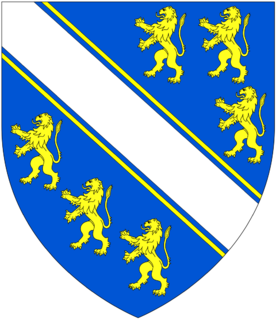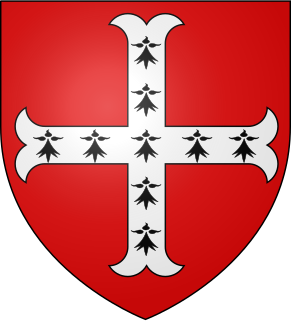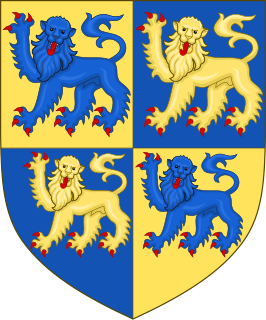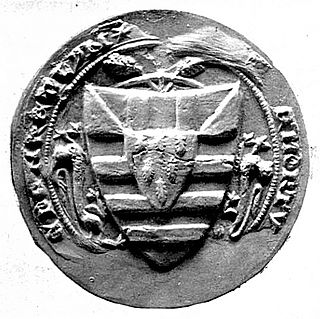
Hugh de Turberville (died 1293) was an English noble and soldier.

Hugh de Turberville (died 1293) was an English noble and soldier.
Hugh de Turberville was from the Turberville family of Crickhowell, Brecknockshire, Wales. From 1271 to 1272 he served as the Seneschal of Gascony. Hugh held Crickhowell Castle from 1273, as mesne lord, the vassal of Reginald FitzPiers. As a knight of the royal household of King Edward I of England, [1] he was one of the commanders during the campaign against Wales during 1277. During the campaign of 1282 during the conquest of Wales, he was one of the leader of eight lances of the cavalry, before appointment as a Knight Banneret, commander of 6000 Foot soldiers from the Welsh Marches. In 1283 he was commander of 1000 foot soldiers and was elevated to Deputy Constable. In 1284 he briefly served as commander of Castell y Bere in Merionethshire, Wales. [2] Turberville was granted Hasfield, Gloucestershire by his daughter's father-inlaw, Grimbold Paunceforte, for life, reverting on Hugh's death to Grimbold's son, Grimbold. During the rebellion of Rhys ap Maredudd he participated in the siege of Dryslwyn Castle in 1287, after which he served in 1288 for a few months as Deputy Justiciar of North Wales. Hugh was again the commander of Castell y Bere, which he held until his death in 1293.
Turberville appears to be the father of Thomas, who was executed as a spy in 1295. [1] His daughter Sybil married Grimbold Paunceforte, who inherited Crickhowell Castle.

Edward II, also called Edward of Caernarfon, was King of England and Lord of Ireland from 1307 until he was deposed in January 1327. The fourth son of Edward I, Edward became the heir apparent to the throne following the death of his elder brother Alphonso. Beginning in 1300, Edward accompanied his father on invasions of Scotland. In 1306, he was knighted in a grand ceremony at Westminster Abbey. Following his father's death, Edward succeeded to the throne in 1307. He married Isabella, the daughter of the powerful King Philip IV of France, in 1308, as part of a long-running effort to resolve tensions between the English and French crowns.

Edward I, also known as Edward Longshanks and the Hammer of the Scots, was King of England from 1272 to 1307. Before his accession to the throne, he was commonly referred to as The Lord Edward. The first son of Henry III, Edward was involved from an early age in the political intrigues of his father's reign, which included an outright rebellion by the English barons. In 1259, he briefly sided with a baronial reform movement, supporting the Provisions of Oxford. After reconciliation with his father, however, he remained loyal throughout the subsequent armed conflict, known as the Second Barons' War. After the Battle of Lewes, Edward was hostage to the rebellious barons, but escaped after a few months and defeated the baronial leader Simon de Montfort at the Battle of Evesham in 1265. Within two years the rebellion was extinguished and, with England pacified, Edward joined the Ninth Crusade to the Holy Land. He was on his way home in 1272 when he was informed that his father had died. Making a slow return, he reached England in 1274 and was crowned at Westminster Abbey.
Richard FitzAlan, 1st Earl of Arundel was an English nobleman and soldier.

Roger Mortimer, 1st Baron Mortimer of Wigmore, of Wigmore Castle in Herefordshire, was a marcher lord who was a loyal ally of King Henry III of England and at times an enemy, at times an ally, of Llywelyn ap Gruffudd, Prince of Wales.

Humphrey (VI) de Bohun, 3rd Earl of Hereford and 2nd Earl of Essex, was an English nobleman known primarily for his opposition to King Edward I over the Confirmatio Cartarum. He was also an active participant in the Welsh Wars and maintained for several years a private feud with the earl of Gloucester. His father, Humphrey (V) de Bohun, fought on the side of the rebellious barons in the Barons' War. When Humphrey (V) predeceased his father, Humphrey (VI) became heir to his grandfather, Humphrey (IV). At Humphrey (IV)'s death in 1275, Humphrey (VI) inherited the earldoms of Hereford and Essex. He also inherited major possessions in the Welsh Marches from his mother, Eleanor de Braose.

Antony Bek was a bishop of Durham and the Patriarch of Jerusalem.
Llywelyn Bren, or Llywelyn ap Gruffudd ap Rhys / Llywelyn ap Rhys or in English: Llywelyn of the Woods. He was a nobleman who led a 1316 revolt in Wales in the reign of King Edward II of England. It marked the last serious challenge to English rule in Wales until the attempts of Owain Lawgoch to invade with French support in the 1370s. Hugh Despenser the Younger's unlawful execution of Llywelyn Bren helped to lead to the eventual overthrow of both Edward II and Hugh.

Madog ap Llywelyn was the leader of the Welsh revolt of 1294–95 against English rule in Wales and proclaimed "Prince of Wales". The revolt was surpassed in longevity only by the revolt of Owain Glyndŵr in the 15th century. Madog belonged to a junior branch of the House of Aberffraw and was a distant relation of Llywelyn ap Gruffudd, the last recognised native Prince of Wales.

Castell y Bere is a Welsh castle near Llanfihangel-y-pennant in Gwynedd, Wales. Constructed by Llywelyn the Great in the 1220s, the stone castle was intended to maintain his authority over the local people and to defend the south-west part of the princedom of Gwynedd. In 1282, war with Edward I of England resulted in the death of Llywelyn's grandson, Llywelyn ap Gruffudd, and Castell y Bere fell to English forces. Edward I expanded the castle further and established a small town beside it. In 1294 the Welsh leader Madog ap Llywelyn mounted a major revolt and the castle was besieged and apparently burnt. Edward did not repair it and it became ruined. Today it is in the hands of Cadw and operated as a tourist attraction.

Coity Castle in Glamorgan, Wales, is a Norman castle built by Sir Payn "the Demon" de Turberville, one of the legendary Twelve Knights of Glamorgan supposed to have conquered Glamorgan under the leadership of Robert FitzHamon, Lord of Gloucester. Now in ruins, it stands in the community of Coity Higher near the town of Bridgend, in the County Borough of Bridgend. Very close to the castle is the battlemented parish Church of St Mary the Virgin, which dates from the 14th century.
Roger Lestrange or Roger Strange was an English knight, commander and royal advisor.

Hugh de Courtenay, 1st/9th Earl of Devon of Tiverton Castle, Okehampton Castle, Plympton Castle and Colcombe Castle, all in Devon, feudal baron of Okehampton and feudal baron of Plympton, was an English nobleman. In 1335, forty-one years after the death of his second-cousin once removed Isabel de Redvers, suo jure 8th Countess of Devon he was officially declared Earl of Devon, although whether as a new creation or in succession to her is unknown, thus alternative ordinal numbers exist for this Courtenay earldom.

Dafydd ap Gruffydd was Prince of Wales from 11 December 1282 until his execution on 3 October 1283 on the orders of King Edward I of England. He was the last native Prince of Wales before the conquest of Wales by Edward I in 1283 and English rule in Wales that followed, until Owain Glyndŵr held the title during the Welsh Revolt of 1400-1415.

Roger Mortimer, 1st Baron Mortimer of Chirk was a 14th-century Marcher lord, notable for his opposition to Edward II of England during the Despenser War.
Sir Gilbert Denys of Siston, Gloucestershire, was a soldier, and later an administrator. He was knighted by January 1385, and was twice knight of the shire for Gloucestershire constituency, in 1390 and 1395 and served as Sheriff of Gloucestershire 1393-4. He founded the family which provided more Sheriffs of Gloucestershire than any other.

The conquest of Wales by Edward I took place between 1277 and 1283. It is sometimes referred to as the Edwardian Conquest of Wales, to distinguish it from the earlier Norman conquest of Wales. In two campaigns, in 1277 and 1282–83, respectively, Edward I of England first greatly reduced the territory of Llywelyn ap Gruffudd, and then completely overran it, as well as the other remaining Welsh principalities.

Crickhowell Castle is a Grade I listed building in Crickhowell, Wales, now largely ruined. An alternative name, "Alisby's Castle", is sometimes used; this is thought to be after a former governor of the castle, Gerald Alisby.

Walter de Huntercombe, 1st Baron Huntercombe (1247–1313) was an English military commander during the Wars of Scottish Independence and a Governor of Edinburgh Castle.
Colonel Dudley Edwin Thornton, CBE, ERD was a British soldier, who commanded the 18th Battalion of the King's African Rifles during the Burma Campaign, and was chairman of the Welch Regiment Museum, in Cardiff, from 1974 until his death.

Edward I of England was associated with a faction of nobles and knights who came from the County of Savoy, and were favoured in England. Savoy became linked to the Plantaganet monarchy of England with the marriage of Edward I's parents Henry III of England and Eleanor of Provence in 1236. Eleanor of Provence was the daughter of Beatrice of Savoy.